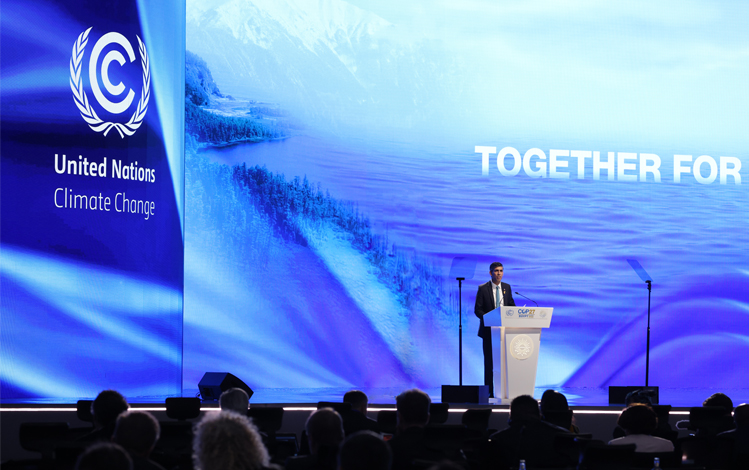

Tech, Trials and Temperatures
Five Sustainability Trends to Watch at COP28 and What They Mean for Communicators
We’re within a month of the largest annual global meeting to discuss all things climate: the UN Framework Convention on Climate Change (UNFCCC) Conference of Parties, colloquially known as COP. This year’s COP — number 28 — will take place Nov. 30 through Dec. 12.
Over the past year, many of the trends we observed in 2022 have continued: stakeholders calling for concrete action and results; youth demanding a role in shaping current and future decision-making; and uncertainty about how to move forward with Loss and Damage funding. Global conflicts, including the war in Ukraine and the war between Israel and Hamas, remain a grim backdrop to discussions around climate, energy security, and the need to transition from a dependence on fossil fuels.
Here are five additional trends rising in prominence as the world gears up for COP28 and what they mean for companies and how they communicate their sustainability efforts, accomplishments and challenges.
1) Disagreement on the role of the oil and gas (O&G) sector
This year’s COP is hosted by one of the largest oil-producing nations in the world, the United Arab Emirates (UAE). For the COP28 presidency, the UAE appointed Sultan Ahmed Al Jaber, the UAE’s minister of Industry and Advanced Technology and CEO of the Abu Dhabi National Oil Company (ADNOC Group). He is also the chairperson of Masdar, a renewable energy company based in Abu Dhabi with projects in 40 countries.
The COP president’s ties to both the fossil fuel and the renewable energy industries have brought strong opinions on the O&G industry’s role in the global renewable energy transition. In May, over 100 EU and U.S. lawmakers signed an open letter calling for the removal of Al Jaber as COP president.
On the other side, leaders like businessman Michael Bloomberg — who also serves as the U.N. Secretary-General’s Special Envoy for Climate Action — have argued it is necessary and essential to engage with the O&G sector to facilitate the global transition to clean energy.
The takeaway for companies and brands is that your stakeholders continue to monitor your use of fossil fuels and engagement with the O&G sector, so communicating your plans and regular progress updates in decarbonizing your products, operations and supply chains is critical. Policy-focused thought leadership in this space is also important. Companies like Microsoft, for example, have seen positive attention for their advocacy efforts to decarbonize energy grids, as well as their efforts to build the markets for currently nascent carbon-free energy sources like fusion energy or sustainable aviation fuel.
2) Increasing climate-related litigation
The past year’s landmark legal cases may be precedent-setting in codifying the responsibilities of both governments and the private sector in protecting citizens and future generations from the negative impacts of climate change. Governments’ failure to act on climate change and protect the rights of current and future generations is being discussed in courtrooms around the world, with cases involving youth in Montana (USA) and Portugal to women in Switzerland.
Companies are not immune to similar lawsuits. A pending complaint filed by 16 Puerto Rican municipalities against various O&G companies argues that for decades these companies were deliberately deceptive in downplaying the effects of global warming. During that time, the communities suffered billions of dollars in damage and loss of human life due to increasingly extreme storms, including Hurricane Maria, which devastated Puerto Rico in 2017.
This rise in climate-related litigation means companies and brands must be truthful and transparent in communicating sustainability efforts, as well as challenges and shortcomings. Although allegations of greenwashing can result in a negative press cycle and loss of trust, climate-focused litigation could mean additional risks, including serious legal and financial repercussions.
3) Rising interest in carbon removal versus carbon reduction
Although reduction of greenhouse gas (GHG) emissions remains the primary action required to mitigate climate change, there is increased interest from businesses, the government and other stakeholders for long-term removal of carbon from the atmosphere, either through nature-based solutions (e.g., reforestation) or engineered solutions (e.g., direct air capture machines that can suck carbon from the atmosphere and sequester it).
The most recent report of the United Nations Intergovernmental Panel on Climate Change (IPCC) notes that CO2 removal will be “essential” to meet the Paris Agreement goal to limit global warming to 1.5°C, and the United States Department of Energy (DOE) announced it will invest $3.5 billion in Direct Air Capture Hubs to remove carbon from the air.
However, some critics suggest that removal is too expensive; has wide variations in quality and durability of removal solutions; and is lacking in accounting standards and policy oversight. Others argue that focusing on carbon removal is a means for the biggest polluters to deflect attention from reducing carbon emissions by eliminating dependency on fossil fuels.
Companies and brands need to consider how carbon removal fits into their broader sustainability strategies. This does not need to be an “either/or” scenario. Investing in carbon removal can be a component of achieving your sustainability goals, but it is important to communicate that carbon removal is being pursued in parallel with your company’s efforts to reduce GHG emissions.
4) The rise of AI — and its potential impact in the sustainability space
Although artificial intelligence (AI) tools have existed for several years, 2023 was the year AI went mainstream, conjuring a sense of both fascination and fear among the general public . Some of the largest tech companies in the world have made huge investments in AI with the ambition that these tools can accelerate progress on global challenges like climate change, environmental degradation and biodiversity loss.
There are great examples of AI being used in this capacity. For example, to track and prevent deforestation in the Amazon or to better predict flooding or other extreme weather events exacerbated by climate change. However, there is also concern over the additional capacities needed to power AI.
Companies and brands directly involved in the creation of AI tools must continue to showcase how AI has a positive impact on society and the planet — and these examples must be practical and operational, not theoretical. Furthermore, these examples should come from both your own experiences as well as those of your customers and partners. Demonstrating how a variety of stakeholders is using AI for good is critical for trust-building purposes, including among potentially skeptical audiences.
For companies and brands not creating AI tools but that may be using them in their work processes, employee communications are key. AI has many unknowns, including how it will impact the future of work and, in turn, people’s jobs. Share how AI tools can be a supplement to, rather than a replacement for, your human employees. In cases where current work may be replaced by AI, consider how to boost employee reskilling opportunities .
Companies and brands also need to share examples of how they are mitigating the environmental impacts of AI, like innovations that enable data centers to use less water or connect to sources of renewable energy.
5) All eyes on extreme weather
One could not escape the headlines that this past July was the hottest month on earth since record- keeping first began — only to be followed by record-breaking temps continuing into August and September. This was accompanied by repeated news cycles regarding devastating wildfires, flooding, droughts and other extreme weather.
For companies and brands, communicating your empathy and understanding — backed by action — is required. People and communities have lost homes, belongings or loved ones. In the immediate aftermath, communications should always focus on resolving immediate human needs. However, in the longer term it is also important to share why your company has made strong commitments toward solving the climate crisis — because it is not an abstract future threat, it has local and highly personal impact today. As WE Communications’ latest Brands in Motion research shows, people want to know what brands are doing to address climate change and other immediate global concerns: 54% of respondents said they want to hear more from brands in times of uncertainty.
Conclusion
It is vital for companies and brands to keep abreast of the different ways sustainability is being discussed in the media and what these trends might mean for your business, your customers, your employees and the communities where you operate.
Communicating with authenticity, honesty and empathy is essential, as communities navigate the very difficult and sometimes very personal impacts of climate change. However, it is also equally important to focus on hope, opportunities and innovation — showcasing your company and leadership’s resolve in forging a more sustainable and more resilient future for all.
The latest blogs from WE
Decoding Gen Alpha: A Primer on the Next Gen of Consumers
Why Gen Alpha Will Fuel Spending This Season
Why Reputation Is a Business Driver in Healthcare


